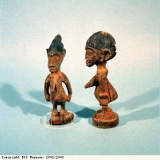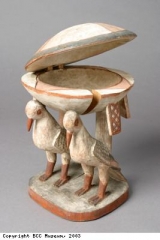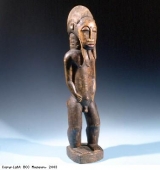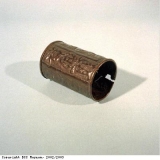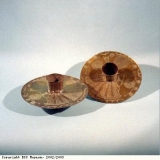Art, culture and technology
West African craftspeople produced a wide range of sophisticated items. Brass objects were made by the brassworkers’ guild in the city of Benin, part of what is today Nigeria. Guilds were professional bodies set up for different craftspeople. The gold ornaments made by the goldsmiths of the Asante people show the high level of technological expertise in working gold. Gold was mined in the area where the Asante lived (now Ghana, West Africa). Copper was called the ‘red gold’ of Africa because it was so highly prized by Africans. It was mined in the modern-day states of Mauritania, Mali and Niger, and in Angola and Zaire. Mining the copper was hard work. From the 14th century brass (a mix or alloy of copper and zinc) was brought into West Africa by European traders. The local metalworkers melted this brass down and used it in addition to the locally mined copper.
The way that societies were organised in the large states encouraged artists and craftspeople. The rulers wanted beautiful objects, to celebrate their high position, and musicians and poets, for their ceremonies and entertainment. Potters, weavers, blacksmiths, leatherworkers, and other craftworkers were often highly skilled. In some states, certain crafts were for the royal court only. The brassworkers of Benin worked only for the oba, the king, making important objects for the royal house. A proverb, or saying, from Benin said that ‘Smiths and woodworkers will never suffer from poverty’. This meant that the skills of metal smiths, woodworkers and other craftspeople were in such high demand that they would always have work, and therefore never be poor.
Everyday objects, such as pots for cooking, baskets for carrying food and cloth for clothing, might be made by ordinary people for their own use. They were also things that people could make to sell at markets for use in the home. Important items, like metal tools used by craftsmen or farmers, and ritual objects, such as bowls used by priests, might be bought from a specialist maker.
Every cultural (or ‘ethnic’) group had its historians. The histories of many of the different African cultures were oral (or spoken) rather than written. They were memorised and spoken or sung by poets and storytellers. These songs and poems were passed down from generation to generation. The stories were told at social gatherings, at work, and at ceremonies such as those for the naming of a child. Olaudah Equiano (a freed slave who wrote his life story) wrote in his book The Interesting Narrative… ‘We are almost a nation of dancers, musicians, and poets.’ He was referring to his own people, the Igbo from what is now Nigeria in West Africa, but it was true of many peoples. The poets and storytellers recorded in their stories, songs and poems, the history of the kings, chiefs, heroes and wise rulers.
Music and dance were often an important part of royal and religious ceremony. The oba, the king, of the great city of Benin, in West Africa, was accompanied by trumpeters who played on great instruments made from elephants tusks. Many ceremonies in the royal court and in the ordinary villages involved dancing and music. Often special objects were needed for the ceremonies. Masks were made for the dancers, as well as costumes, and ornaments like brass bracelets and anklets. This bracelet is from the Edo people of Benin. The decortation is carefully hammered into the brass. These Adala anklets are from the Igbo people of Nigeria. They are worn by young women who are ready to marry. Bowls were needed to hold foods such as ‘kola’ nuts, which were offered to guests. Figures were made to represent gods, spirits or people.
The wooden figures shown here were carved by craftsman. They are called ere ibeji figures and are from the Yoruba people of Nigeria. The figures represent a pair of twins and were carved when one or both twins died. The Yoruba people believe that twins bring prosperity. If a twin died, it was thought that the other twin might be in danger. So a carving was made to represent the dead twin, and was fed, carried and cared for by the mother as if it was still alive. This was to make sure that the spirit of the dead child or children would be happy and content.
Also pictured here is the blolo bian or spirit husband figure. It is a wooden figure from the Baule people of Ivory Coast , West Africa. The Baule people believed that each person had a husband or wife who lived as spirits in the ‘other world’. It was thought that the spirit husband or wife could become jealous of the real life husband or wife. A figure of the spirit husband or wife was therefore made and cared for by their real life other half. The other carving pictured is a kind of bowl or dish. It is being held by a figure of a woman with a baby tied to her back. The dish is used for divination – or predicting the future. In Nigeria, Ifa is a system of prediction in which a special priest will advise people about their lives. People ask the priest questions, and 16 palm seeds are used to give the answers. This bowl would have held the palm seeds, or a gift of kola nuts.
These objects were made by skilled craftspeople who were responding to the spiritual and ceremonial beliefs of the people. This relationship has created beautiful objects over many generations.
